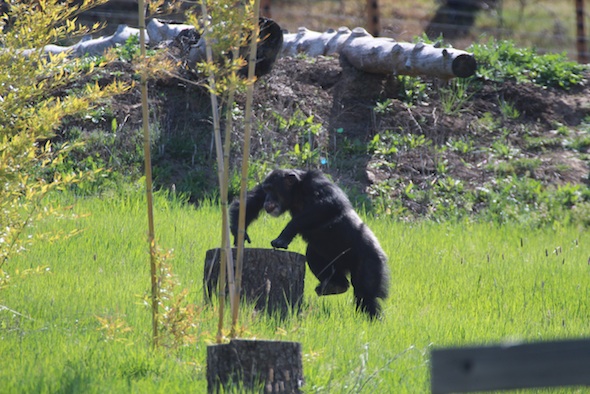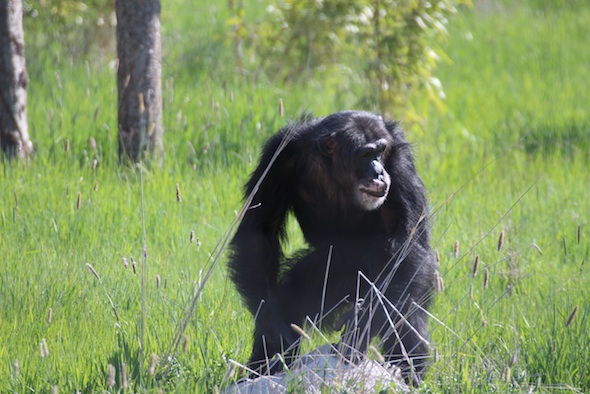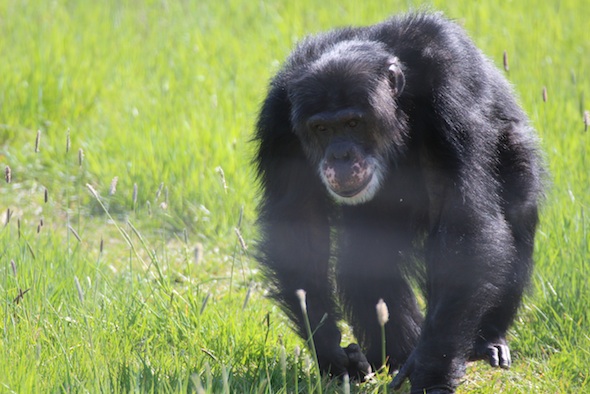If Chimpanzee Sanctuary Northwest were a high school, Burrito would be the guy wearing the wrong clothes and saying the wrong things.
Chimpanzee groups operate under a strict set of social rules. Wild chimpanzees learn these rules as children by watching the older members of their group. Most of the chimps at the sanctuary, despite having grown up in entirely unnatural circumstances with limited exposure to other chimps, seem to have some understanding of these rules. But Burrito hasn’t read the rulebook. He doesn’t even know where to find a copy.
Burrito’s hormones and millions of years of evolutionary pressure are giving him bad advice. As a male chimpanzee, he is instinctually driven to show everyone he’s in charge. He does this multiple times each day through intimidating dominance displays. Wild male chimps have these same instincts, but their instincts are tempered by social learning. A free-living male chimp might get the following message from his brain: “It’s time for a display, but the alpha’s over there, so steer clear of him, and be sure to keep it short and to the point.” The message Burrito receives seems to be less nuanced: “GO!!!”
None of this is Burrito’s fault, of course. He was born in a laboratory and lived most of his life alone. He never had peers to learn from. Consequently, he has all of the instinct and none of the experience. This has gotten him in some trouble with the other chimps at the sanctuary, and he often seems out of his element. But he has come a long way. At the age of 32, surrounded by a stable group of chimpanzee friends, he is learning the skills and lessons he should have learned as a kid. He is fitting in more and more everyday. Burrito is finally growing up.








Love that Burrito!
Love Mr. B! Glad he is making progress!
Awe Mr. B our overgrown kid! He is such a wonderful goofball who is fun to watch growing up. Even if he will never be the leader of this group it is a joy seeing him learn the ropes. Love you Burrito!????
Elizabeth, your opening line and the first photo had me laughing right from the start! However, in the top photo Burrito sure does look larger than life and very impressive! (Okay so he looks a little goofy, but still impressive!)
I have a silly question, is “displaying” and “bluffing” the same the same thing? Is it extra hard on Mr. B since he is the only male and has no role models? I am just finishing the last chapter of “Chimpanzee Politics” and it puts your post in an interesting light!
Not a silly question at all, Kathleen. I haven’t heard the term “bluffing” be used interchangeably with “displaying,” but it’s possible. A display typically consists of a chimpanzee, hair standing on end, running or swaggering bipedally, often while banging on or throwing objects. The goal is to look as scary as possible and to gain the respect of one’s audience.
I wasn’t able to find a good video of Burrito displaying (I’ll try to get one!). Here’s a video of one of Jamie’s displays, to give you some idea – though each chimp has his or her own style: https://chimpsnw.org/2013/01/jamie-and-her-barrel/
Thank you Elizabeth! That was a great link to connect to and I enjoyed J.B.’s explanation that accompanied the post. I understand what a “display” is so I guess I am curious what “bluffing” is all about — from my reading (Franz de Wall’s “Chimpanzee Politics”) Mr. De Wall discusses displaying, bluffing, and then there is the “bluff over”. I can’t quite figure out what the difference is between “displaying” and “bluffing”. Is a bluff just standing bipedally with hair on end and a full display involves that plus running, charging, and banging? I find chimpanzee behavior so fascinating!
There is something called a bluff charge which involves an individual charging or running quickly toward another individual but not making contact (hence the “bluff”). This is a threat behavior that might be seen as part of a display; whereas a display is a collection of multiple threat behaviors. I hope that helps!
Thank you Elizabeth!